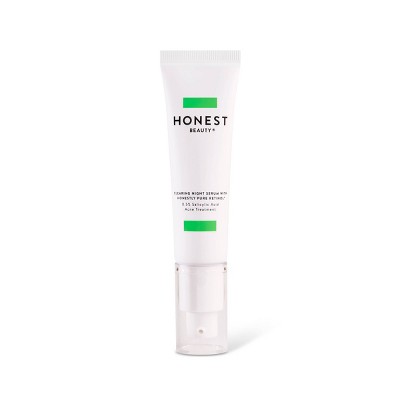PRODUCT REVIEW

Eva Naturals Vitamin C Plus Skin Clearing Serum
Cheaper alternatives

What can the product work for?
Anti-blemish
What does the product description say?
Acne and other skin conditions leave your complexion looking red and uneven.
Anti-aging
What does the product description say?
Vitamin C is the star of our blend as it offers anti-aging benefits like UV protection and helps repair sun-damaged skin.
Evens skin tone
What does the product description say?
The Niacinamide found in our formula supports healthy skin by naturally reducing inflammation and soothing troubled skin for an overall more even skin tone!
Moisturizing
What does the product description say?
We paired it with Hyaluronic Acid, which provides incredible hydration, for smooth, younger-looking skin!
Exfoliation
Anti-oxidation
Honesty check
How honest is this product?
| Promise | Can it deliver? |
|---|---|
| Anti-aging | |
| Moisturizing | |
| Evens skin tone | |
| Anti-blemish |
Buy now
We receive a small commission for purchases made through these links at no cost for you. Thank you for your support! Learn more
Can it cause trouble?
- Overall product irritation risk
- Acne & comedogenic risk ingredients: 1
Potential irritants
Comodogenic ingredients
User reviews (1)
Similar products & dupes
 Eva Naturals - Vitamin C Plus Skin Clearing Serum |  Dr. Jart+ - Dermask Solution 1pc Sponsored |  InstaNatural - Age Defying & Skin Clearing Serum & Hyaluronic Oil Free Moisturizer Duo |  Naturium - Vitamin C Super Serum Plus |  Revolution - Skincare 0.3% Retinol with Vitamins & Hyaluronic Acid Serum |  Honest Beauty - Clearing Night Serum With Honestly Pure Retinol |  CosMedix - Clarity Serum Skin Clarifying Serum |  REVOLUTION SKINCARE - Dark Spot Corrector Serum |  Radiant Glow Botanical - Advanced Acne Serum |  TONYMOLY - Vital Vita 12 Firming Ampoule |  Marinne - Retinol & Collagen Cream-Serum - 1% Retinol |  MDSolarSciences - Revitalize Retinol Serum | |
| Price | ||||||||||||
| WIMJ similarity score |
65%
|
88%
|
83%
|
83%
|
79%
|
78%
|
73%
|
73%
|
70%
|
69%
|
68%
| |
| Key ingredients |
| Common:
Other:
| Common:
Other: | Common:
Other:
| Common:
Other: | Common:
Other: | Common:
Other: | Common:
Other: | Common:
Other:
| Common:
Other:
| Common:
Other: | Common:
Other:
|
| Irritancy | IRRITANCY
HIGH
| IRRITANCY
HIGH
| IRRITANCY
HIGH
| IRRITANCY
HIGH
| IRRITANCY
MEDIUM
| IRRITANCY
HIGH
| IRRITANCY
HIGH
| IRRITANCY
LOW
| IRRITANCY
MEDIUM
| IRRITANCY
HIGH
| IRRITANCY
MEDIUM
| IRRITANCY
HIGH
|
| Potential Irritants |
|
|
|
|
|
|
|
|
|
|
|
|
| All ingredients |
|
|
|
|
|
|
|
|
|
|
|
|
Ingredients & concentrations
All ingredients
Key Actives
Potential irritants
Comodogenic ingredients
All ingredients
Ingredient list view
Water, Rosa rubiginosa seed oil, Rosa canina seed oil, Squalane, Glycerin, Sodium ascorbyl phosphate, C10-18 triglycerides, Candelilla/jojoba/rice bran polyglyceryl-3 esters, Glyceryl stearate, Niacinamide, Retinol, Salicylic acid, Sodium polyacrylate, Cassia angustifolia seed polysaccharide, Hyaluronic acid, Dimethyl sulfone, Cananga odorata flower oil, Melaleuca alternifolia leaf oil, Xanthan gum, Tricaprylin, Cellulose acetate butyrate, Pentaerythrityl tetra-di-t-butyl hydroxyhydrocinnamate, Hydroxyethylcellulose, Cetearyl alcohol, Sodium stearoyl lactylate, Ethylhexylglycerin, Phenoxyethanol
Sources
- Nutrient composition of rose (Rosa canina L.) seed and oils
- Characterization of Rosehip (Rosa canina L.) Seed and Seed Oil
- Bioactive ingredients of rose hips (Rosa canina L) with special reference to antioxidative and anti-inflammatory properties: in vitro studies
- Glycerol and the skin: holistic approach to its origin and functions
- Sodium ascorbyl phosphate shows in vitro and in vivo efficacy in the prevention and treatment of acne vulgaris
- Sodium ascorbyl phosphate in topical microemulsions
- Final report of the safety assessment of L-Ascorbic Acid, Calcium Ascorbate, Magnesium Ascorbate, Magnesium Ascorbyl Phosphate, Sodium Ascorbate, and Sodium Ascorbyl Phosphate as used in cosmetics
- Regulation of collagen synthesis in human dermal fibroblasts by the sodium and magnesium salts of ascorbyl-2-phosphate
- Comparison of clinical efficacies of sodium ascorbyl phosphate, retinol and their combination in acne treatment
- Application of l-ascorbic acid and its derivatives (sodium ascorbyl phosphate and magnesium ascorbyl phosphate) in topical cosmetic formulations: stability studies
- Sodium L-ascorbyl-2-phosphate 5% lotion for the treatment of acne vulgaris: a randomized, double-blind, controlled trial
- Niacinamide - mechanisms of action and its topical use in dermatology
- Gehring, W. (2004). Nicotinic acid/niacinamide and the skin. Journal of Cosmetic Dermatology, 3(2), 88–93. doi:10.1111/j.1473-2130.2004.00115.x
- Retinoids in the treatment of skin aging: an overview of clinical efficacy and safety
- Improvement of naturally aged skin with vitamin A (retinol)
- A comparative study of the effects of retinol and retinoic acid on histological, molecular, and clinical properties of human skin
- Salicylic acid as a peeling agent: a comprehensive review
- Beta Hydroxy Acids
- A review of toxicity from topical salicylic acid preparations
- Glycolic Acid Peels Versus Salicylic–Mandelic Acid Peels in Active Acne Vulgaris and Post‐Acne Scarring and Hyperpigmentation: A Comparative Study
- Safety Assessment of Polysaccharide Gums as Used in Cosmetics
- Anaphylaxis Due to Senna (Cassia angustifolia)
- Contact Burn with Blister Formation in Children Treated with Sennosides
- Efficacy of a New Topical Nano-hyaluronic Acid in Humans
- Physiochemical properties and application of hyaluronic acid: a systematic review